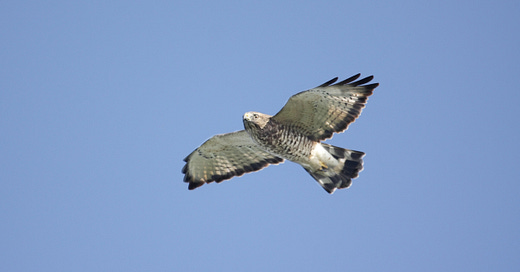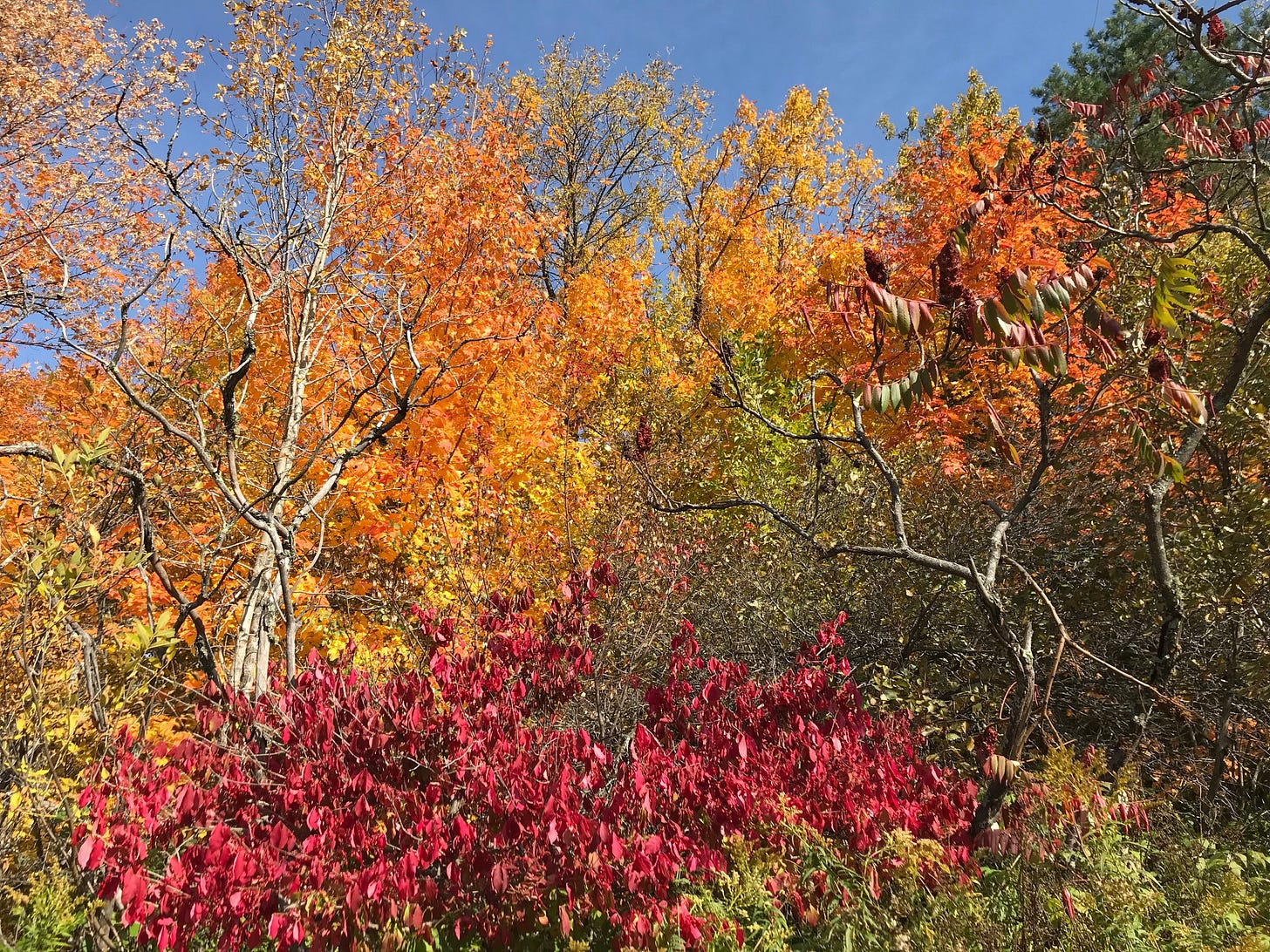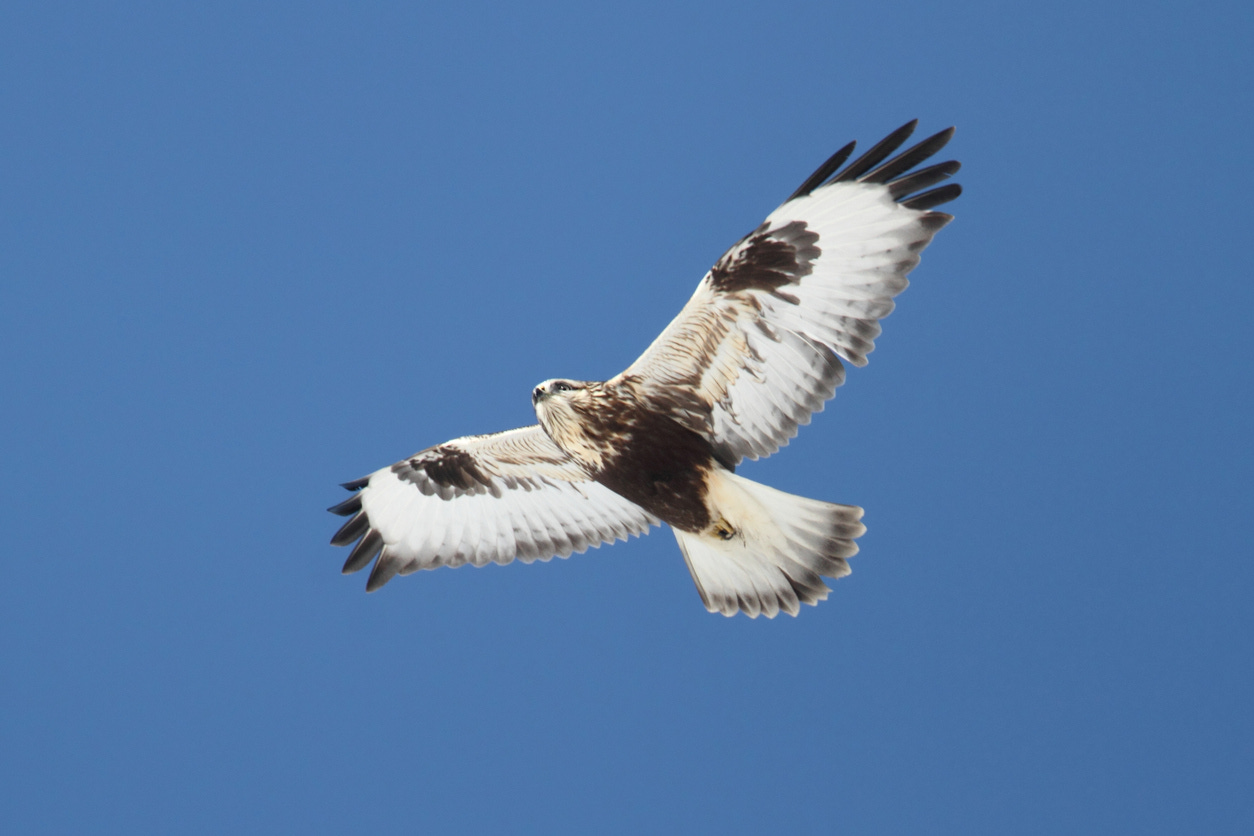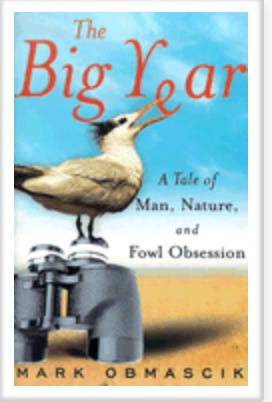The Northern Naturalist #5
Broad-winged Hawks and the Rush of Autumn, Five Ways to Know Which Buteo You Are Watching, Review: How I Almost Became a Household Name: The Big Year (book) and The Big Year (movie), plus more.
Thank you for opening and reading my newsletter! The newsletter is still free, notwithstanding any messages you may have received to the contrary. I think I have figured out how to force these messages to cease, but if and when the newsletter goes partially-paywalled, there will be ample notice here.
Also, occasionally I write a Substack note, which does not appear in the newsletter. To read these, you need to visit the site and click on “notes,” if you are interested.
Broad-winged Hawks and the Rush of Autumn
“September came in with golden days and silver nights…The high branches of trees swayed gently in the night breeze, and their leaves whispered softly in the stillness.”
—J. R. R. Tolkien, The Return of the King
Autumn is a season of rhythms in the natural world. As I write this, it’s hot (for here), but a cold front will come tonight, we’ll have rain, and tomorrow it will be cooler. This ratcheting down of the year will continue right into snow season, hard as it is to imagine today!
An old friend of mine, ornithologist Terry Wiens, once pointed out that the cold fronts often come through at a slower pace than the weather forecasters think. This fits my observations, and in general, fall migration moves at a more languid pace than the spring, which features a flush of hormonal intensity as birds push northward.
The Broad-winged Hawk flight is an exception. When they come, they come all at once. Here, they come sometime between September 10th and September 22nd. This big flight is driven by diet and lifecycle.
Broad-wings are stocky buteos (a genus of chunky, largish raptors with broad wings and tails—in Britain, they are called “buzzards.”) They are one of most common raptors throughout the eastern United States, and their breeding range extends well north into Canada, and in the north, it extends west all the way to Alberta.
They are secretive (to us), spending much of the breeding season under forest canopies. On a sunny mid-day, they often fly above the canopy, calling their distinctive whistle.
Seen from beneath (your most likely vantage), adult light-morph (which means plumage—there is a dark-morph but light-morphs are more common) broad-wings have dark tails with prominent white bands across them. The wings are light-colored with a dark outline along the trailing edge and wingtips. Young birds (which we will see a lot of this time of year) are buffier in general, with much more streaking underneath on the breast.
Broad-wings in migration always seem more neat and tidy to me than other buteos. If you drew an outline around an image of a soaring broadwing, touching the beak, wingtips, and end of the tail, it would be an oval disc-shape—they can sometimes seem like a flying plate. There is little lift in the wings.
They are most similar to the closely-related Red-shouldered Hawk (unusual here, but we do see some every year), but Red-shouldereds have a profile of reaching their wings forward, as well as windows (light patches) across their wings near the end of the wing. Of course, if you can see their red shoulders, that’s a good fieldmark too.
Broadwings prefer to nest in moist deciduous forests, where they eat a wide variety of prey, including insects, frogs, snakes, lizards, small birds, and rodents. Cold-blooded prey is an important component of their diet, although the few studies of this have yielded quite a variety of proportions of cold- to warm-blooded.
They hunt from perches for the most part. There are records of them hunting in flight, but they don’t usually stoop (dive from a height) on their prey.
Their nests are stick nests, a couple of feet in diameter.
I find it just as exciting to find a broad-wing in the woods in the summer, because they don’t show themselves so readily as during migration. I once watched one down a pretty good sized snake as it sat on its nest.
Once I was birding in the bog with my late friend, Al Loken, and he had one of those little wooden Audubon squeaker calls. A broadwing jumped up nearby and began circling, dropping closer and closer to what I would guess sounded like a mouse, until it figured out that this mouse was too big and flew off.
What has made Broad-winged Hawks famous, however, is their spectacular migration flights. All of the well-known eastern hawk-watch sites feature massive flights of Broad-winged Hawks.
This is due to the large component of cold-blooded prey in their diet. Once the hard frosts begin hitting in the north, this prey vanishes, and the broad-wings need to be on the move.
Contrast this with the fall migration of Bald Eagles, a species that eats a wider variety of food, including carrion, fish, and larger mammals. Eagles migrate across several months, and some years it feels like they hang around as long as they can, until they are pushed south by a blizzard.
The Broad-winged Hawks, though, come all at once. They are headed to Central and South America, and most fly around the west side of the Gulf of Mexico. This leads to the largest daily flights of any raptor. Hawk Ridge will have tens of thousands; the sites on the Gulf in Texas will have larger flights as the river of raptors is joined by other northern birds, and at Veracruz, Mexico, the flights will be in the hundreds of thousands.
They move on days when it is sunny with good visibility, warm, and breezy, but not too windy. On other days, they will sit tight if they can, and maybe hunt.
In the days leading up to the autumnal equinox, if there’s sunshine, winds with a westerly component (northwest, west, southwest; north might also be good) and below gale-force winds, get out to your nearest hillside and see if you can experience the spectacular migration of Broad-winged Hawks.
It’s one of the best things about the season of “golden days and silver nights.”
Five Ways to Know Which Buteo You Are Watching
This little article will give you a start on the three species of buteo you’re most likely to see in Northern Minnesota, Wisconsin, and Michigan, but note that others are sometimes seen here (especially Red-shouldered, and less-often, Swainson’s, and Ferruginous Hawks).
Note also that each species has other plumages (juvenile and adult, other morphs, etc.) that I can’t deal with in a short article, especially one that’s mainly text. Hawks can be a complicated group of birds. Field guides have some illustrations, plus there are some fine specialized guides available: Hawks at a Distance, and Hawks from Every Angle, by Jerry Liguori; Hawks in Flight, by Pete Dunne, David Sibley, and Clay Sutton; and the field and photographic guides by Brian Wheeler and William Clark.
The good news is that eighty percent of the raptors you see will present typical and fairly straightforward appearances. Just use a little humility in your proclamations about what you’re seeing; and if someone points out your misidentification, you can always resort to the tried-and-tried, “Oh, I was looking at a different bird!”
Timing
During fall migration, Broad-winged Hawks fly early (see the article about them in this issue.), Rough-leggeds fly later, not really getting going until well into October. Usually, there’s not much overlap in timing between the two.
Red-tailed Hawks, on the other hand, can be seen anywhere, anytime. They are one of the most widespread bird species in North America. Still, their numbers build through September, and October is the month we see the most.
Size and Manner of Flight
Red-tails look the most massive of the three, with wide wings, tail and body. They soar like eagles, but they have a slight dihedral (upward flex) in their flight.
Rough-leggeds have a “loose” or “sloppy” flight; that is, more flex in the wing, and the stroke sometimes seems to ripple down the wing.
Broad-wingeds have a quick, deep, crisp stroke. They turn in smaller circles than the others when soaring. When they glide, they may hold their wings slightly down-turned.
Wing and Body Shape
Red-tails have wide wings, and the trailing edge bulges out a little. When soaring, their wings appear to reach forward in the sky.
Rough-leggeds have long, relatively-straight wings that appear a little more blunt at the ends than the others.
Broad-wingeds are compact, with shorter, more pointed wings.
Fingers
The primaries (large, outer flight feathers) on a buteo’s wing stick out from the end of the wing like “fingers”. The technical term for these feathers is “emarginated primaries.” Broad-wings only show four; the others, five.
Plumage Marks
An adult Broad-winged Hawk will have a pale underside with a broad, white band in the tail, with two black bands front and back of the white. The outer wing will show a bold, dark margin on the ends and trailing edges. Juvenile Broad-wings can have a hooded appearance, with streaks extending down the breast from the “hood.”
An adult Red-tailed Hawk (again, this may only be for typical, light morph birds) will have a red upper-tail, which you may not be able to see from the ground. Look for dark patagial marks (dark bars along part of the front end of the underwing). Redtails have these in virtually all plumages, but of course, they don’t stand out on dark birds. Many redtails have a dark belly-band and white mottling on the back. These are actually pretty good field marks, but other species can sometimes have belly-coloring or mottling on the back that can fool.
Rough-legged Hawks, which nest in the far north, show up with the snow, and they can look a little wintry, with deeply-contrasting black “wrist" patches and black belly against pale, almost translucent wings. The bases of the outer primaries will show white, and the base of the tail will be light, especially from above.
Buteos can be some of the most striking birds. I am asked more about hawks in the course of my daily life than any other group except woodpeckers. Unfortunately, when I ask for details, the most common answer is “It was kind of big and brown.” As you can guess from this article, hawk identification is little more complicated than that. I’m afraid one could make even more qualifications than I have here about each of my statements about buteos above.
It’s my hope that you can get out to look for hawks somewhere over the next couple of months, and that the information here can give you a head start on knowing what you’re seeing.
How I Almost Became a Household Name: Reviews of The Big Year (the book, Atria Books, 2008) and The Big Year (the movie, Twentieth Century Fox, 2011)
Beginning in the 1930s, a few birders began to undertake what came to be known as a “big year”—trying to see all the species you can in one calendar year. You can choose your own geographical context: state big year, county big year, township big year, etc. For the rest of this review, it will mean “North American Big Year,” which here means the United States and Canada, minus Hawaii (the designated area of the American Birding Association prior to 2016). In recent years, birders have done actual North American big years, big years including Hawaii, and others.
Roger Tory Peterson’s famous big year with James Fisher, chronicled in the book Wild America, resulted in a count of 573 species. As birding became more popular and transportation more accessible, the number of people conducting big years grew too. Even so, only a tiny minority of birders try a continental big year. The expense, the required time flexibility, and other factors make it impossible for many. Plus, it requires an obsession unusual even among listers.
In 1998, three birders did famous big years, and their attempts became a competition between the three of them. Al Levantin, Sandy Komito, and Greg Miller battled all year long, and their year was the subject of The Big Year: a Tale of Man, Nature, and Fowl Obsession, by Mark Obmascik. At the time they began, Komito held the record of 722 species. There was no prize—they all just chose to do this on their own.
There are at least twenty books telling the stories of other big years. I have enjoyed the ones I have read, but I have noticed a problem with them: they boil down to being the story of one damn bird after another. Even a bird-fanatic like me doesn’t care where they got their Rock Pigeon or even their Nutmeg Mannikin. Big years involve many great birding experiences, a lot of unusual adventures, major frustrations when missing a planned sighting, and hours and hours of boredom.
Obmascik dealt with this problem by entwining the personal experiences of all three birders in his book. He’s an award-winning journalist, and the text has a journalistic feel. He covers the story of each birder well, and he does it without many missteps. (Birders are used to reading and hearing fairly outrageous mistakes when reporters or others write and talk about our pursuit.) I don’t like the sub-title, which may not have been Obmascik’s work. They were seeking all kinds of birds, not just the gamebirds meant by the word “fowl.” (Memo to self: you’d have more friends if you didn’t complain about stuff like this.) The presence of three characters helps a lot in covering over the slow spots.
As it happens, all three men came to Duluth that year, and I guided two of these three big year guys in 1998. Sandy Komito arrived first. He sought three birds: Black-backed Woodpecker, Mourning Warbler, and Connecticut Warbler. He arrived early one day, we found all three, he got great looks, and that was that. Sandy was friendly but reserved. He had a detailed plan, and between birds, we drove to pay phones, where he would call various hotlines to check on rarities and learn if he needed to change his flights. In retrospect, in those pre-cell phone days, my knowledge of the locations of pay phones in the north woods was possibly as valuable as my bird knowledge.
Greg Miller booked me for two days in June. We had a blast. He is not only a friendly guy, but a fun one, and, like Komito, a superb birder. Birding with Greg that day was the first time I had an extended birding trip with a great birder from another region (Ohio). He kept trying to turn Chipping Sparrows into Worm-eating Warblers (the trills are similar); it never happened, but it was enlightening to think about our common birds in a new way.
Greg had a list of nine targets, and we rolled through them easily on the first morning, except for one bird—Black Tern. In those days, I used to see Black Terns now and then (they are declining due to loss of their marshland habitat), but we missed them that morning. I suggested going to Mille Lacs Lake, where I had seen some earlier that month, and since we had nothing else to chase, off we went. We drove all around the lake (68 miles), scanning every dock (that’s a lot of docks). Lots of Forster’s Terns. A few Caspian Terns. No Black Terns. We had just started back toward Duluth, when I spotted a car with binoculars sticking out the window. I zipped over there, and it was Jo and Steve Blanich, the greatest birders in all of of Crosby, Minnesota, and well beyond.
When I asked where we could find a Black Tern, there was a little pause. It’s just not enough of a sought-after rarity to be on the tip of one’s tongue. They looked at each other, and Jo said, “How about Rice Lake National Wildlife Refuge?” Off we buzzed, and when we arrived at the observation tower, there were several hundred Black Terns, whirling around the marsh like big swallows, a beautiful sight even outside the context of having looked for a bird unsuccessfully for hours and hours and then finding it. (I haven’t seen the Blaniches in quite a while; Steve died in 2017, and I just learned that Jo died last week at the age of 96! May they rest among the saints and the Black Terns!)
By the time we got back to Duluth, it was late, and now we come to the incident which has generated so much controversy. Greg said he was leaving in the morning for North Dakota. I replied along the lines of “Dude, you booked me for two days.” And he said, of course, “But we found everything today!” I had no good retort to that, so I gave him all my ideas about where to go in North Dakota, and we had a fond farewell.
In the book (p. 81), this incident was concluded, “Benson was mad. Miller was ashamed.” It wasn’t really that big of a deal. I don’t recall being mad, and I think I handled it with candor and grace. I think I know how it ended up being cast this way. Greg did his entire big year on credit cards. He would max out, drive home and work some, then max out again. This was in marked contrast to the other two, who flew all over the continent, etc.
Another bloomer can be found earlier on the page: “From 4:30 A.M. to 10:30 P.M. Benson had busted his tail to show Miller an amazing 111 species, one of the greatest birding days of both men’s lives.” (p. 81) It was a great day, but not because of the species total, which my day lists have exceeded many times, and I’m sure the same was true for Greg.
I guess with fame comes misinformation. Based on the drama of my one-page appearance in the book (p. 81), when I heard that a feature movie was to be made of The Big Year, I began dreaming of what life would be like with even greater fame. Who would play me? George Clooney? Daniel Day-Lewis?
In the years since 1998, the final tally of 748 and other records of the nineties have been left far behind. The current record, excluding Hawaii, is 784, set by John Weigel in 2019. Quite a few big years have passed 748, but at the time of the setting of the book, this was a stratospheric count.
The movie came out in 2011, and, due to the references to Duluth, there was a special showing at a small theater here. When the Sax-Zim Bog was mentioned, the audience cheered.
Steve Martin played Al Levantin, Owen Wilson played Sandy Komito, and Jack Black played Greg Miller. It’s a good movie. As many of the reviews said, “genial.” The actors who played the three protagonists each did well. There are a few birding bloopers, but it could have been a lot worse. They hired Greg to be the birding consultant for the movie, and I’m sure that helped. I think the movie communicated the excitement and wonder birders feel about finding something we haven’t seen before, along with the obsession of a big year.
A few years later the Friends of Sax-Zim Bog brought Greg Miller back to Duluth for a special showing, and we’d stop the projector now and then so he could regale us with tales of the big year and of the making of the movie.
By now, you will have noticed that there is no mention of George Clooney or any else playing me. Yes, it’s true—I was left on the cutting room floor. I don’t actually know if I made it even that far, in spite of my pivotal role in the plot of the book (p. 81). So, I am left to wonder what might have been. I have also forced everyone I have guided since then to hear my tale of woe. They have all been a little cagey about it, but I’m sure many were thinking, “so you were that one guy in that one book!”
In spite of being the most famous birding movie of all time, the movie was not a commercial success. It cost $41 million dollars to make and grossed $7 million worldwide. On Rotten Tomatoes, it garnered scores in the low forties among critics and with the audience.
No doubt the creators have some regrets about who they left out.
News and Notes
Gray Catbird and autumn butterflies: When we returned from a week-long vacation, I thought the Gray Catbirds (Issue One: northernnaturalist.substack.com/p/the-northern-naturalist-1) had likely headed south. Then, yesterday, I heard them, and again this morning. I decided to put grapes out again. I haven’t seen them eating yet; but my wife, Pam, found two of the stars of last issue’s (Issue Four:https://northernnaturalist.substack.com/p/autumn-butterflies) butterfly article, Mourning Cloak and Comma, nectaring at the grapes.
Also in Issue Four, I noted the usual flight of Common Nighthawks this time of year. True to form, they came in large numbers, especially on Monday, August 26th, when counters at Hawk Ridge Bird Observatory tallied 11,970!
I found this chart on the internet:
Since it didn’t reference any actual research, I don’t feel obliged to reference where I found it (also, I lost the reference). I have, on occasion, been ridiculed for being a birder. One remembers the garbage-truck driver at the Superior, Wisconsin dump making a “cuckoo” circle by his head as he stared at me while I scoped out a Great Black-backed Gull. Also, the local motorcyclist who roared by me at Hawk Ridge, shouting, “Loser!” In an enjoyable twist of fate, it turned out that this was the same guy whose wallet I found a few days later—who’s the loser now? And there have been other incidents.
Even so, I feel that being lumped in with “collecting figurines” here is a bit much. I get it, the point of the chart is to ridicule watching videogames. I’m happy to join in with ridicule for that, along with collecting figurines. Having recently been in the presence of a grown man who broke out some magic tricks at a picnic, I can testify that he did have the rapt attention of several women in his vicinity, although I saw no evidence that they found it attractive. I myself was intrigued by his wallet, which when opened, flared up real flames about six inches. I don’t know how he did it. It left me curious, yet somewhat ready to move further away.
I think I have read somewhere that a writer choosing a newsletter topic should pick something at least a little more popular than collecting figurines and online trolling, and I believe natural history and birds is right in the sweet spot.













